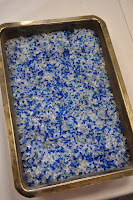 Silica gel is a form of silicon dioxide (SiO2) with an expansive microscopic pore
structure that provides a large internal surface area capable of absorbing and
desorbing water molecules. It has been widely used as a desiccant for food and
other goods since the beginning of the 20th century. Because art
objects require a stable environment, the museum world uses silica gel to
control the relative humidity (RH) in exhibition cases and in storage. At Kaman
Kalehöyük silica gel is used in storage containers to stabilize the RH. The gel
is most often used to create a low humidity environment (≤ 30%) for metal
objects, because many of the primary deterioration reactions for metals involve
water.
Silica gel is a form of silicon dioxide (SiO2) with an expansive microscopic pore
structure that provides a large internal surface area capable of absorbing and
desorbing water molecules. It has been widely used as a desiccant for food and
other goods since the beginning of the 20th century. Because art
objects require a stable environment, the museum world uses silica gel to
control the relative humidity (RH) in exhibition cases and in storage. At Kaman
Kalehöyük silica gel is used in storage containers to stabilize the RH. The gel
is most often used to create a low humidity environment (≤ 30%) for metal
objects, because many of the primary deterioration reactions for metals involve
water.
An important part of the
conservation work at Kaman Kalehöyük is re-conditioning and replacing the silica
gel in storage. Some of the granules are doped with a moisture indicator (cobalt(II) chloride) that gradually changes color from blue to pink
when it transitions from the anhydrous to the hydrated state.
Pink silica gel is removed from the storage containers and reconditioned
in the oven. Once it has returned to the anhydrous (blue) state, the silica gel
can be returned to the many storage containers.













